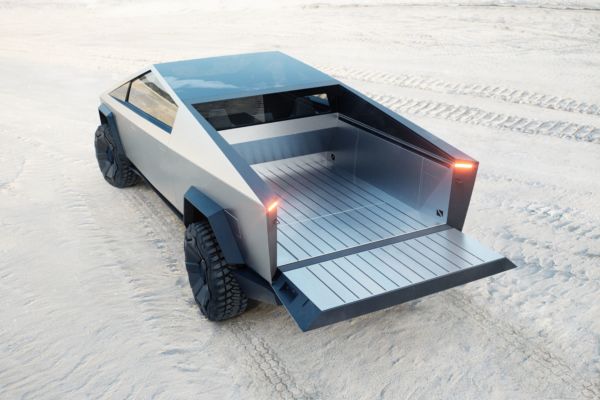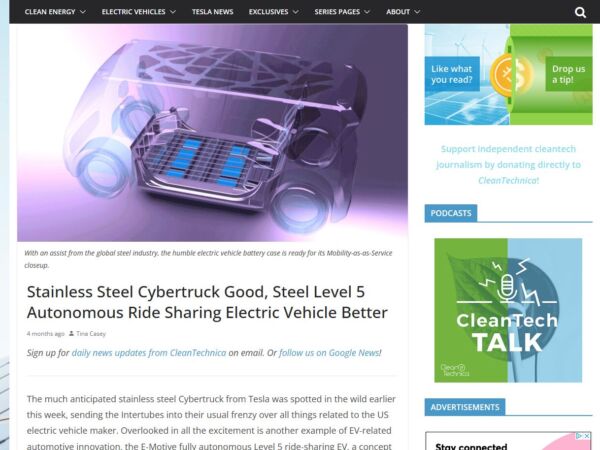Tesla Takes Advantage of Steel Strength for Cybertruck Exoskeleton
“If there was something better, we’d use it.”
~Tesla
Why Steel? Strength and Innovation
Elon Musk has confirmed high quality 300 series stainless steel as their engineering team’s material of choice for the Cybertruck.
It’s corrosion resistant, strong and affordable – that’s why the Tesla Cybertruck team chose a stainless steel alloy to create the Cybertruck exoskeleton.
Tesla.com describes the new vehicle as … “built with an exterior shell made for ultimate durability and passenger protection. Starting with a nearly impenetrable exoskeleton, every component is designed for superior strength and endurance, from Ultra-Hard 30X Cold-Rolled stainless-steel structural skin to Tesla armor glass.”
According to matmatch.com, “The Cybertruck exoskeleton is made from Tesla’s own stainless steel alloy, referred to as the Ultra-hard 30X Cold-rolled Stainless Steel. While the blend is proprietary, Elon mentioned during the product launch that the exoskeleton material of the vehicle is the same as the SpaceX Starship shell.”
Steel Means Exterior Strength
The material impacted both the design and the manufacturing process for the vehicle. More from matmatch.com: “Besides the material used in the Cybertruck, Musk clarified that Tesla went with the planar design as a result of the cold-rolled 30X stainless steel’s capability to break a stamping press. Whether that statement is said in layman’s terms or the material is indeed too hard for pressing, the key implication is that Tesla would have to devise a new body manufacturing method that does not apply standard automotive manufacturing techniques.
“Musk has shared that the body panels will be laser cut and that standard stamping was not implemented in the Cybertruck prototype. Besides the impact on aesthetics, this new body manufacturing method will provide Tesla the flexibility to adjust, reduce cost, and improve manufacturing time with its simple flat panel design.”
Steel Means Cost Savings
Another reason Tesla is using steel innovation is to save millions on its Cybertruck program. According to WardsAuto:
“With the flat panels and straight lines, the automaker doesn’t need stamping dies to shape the body panels, or even blanking dies to form steel blanks. They can waterjet or laser-cut the panels to size and even cut out the window openings this way.
“Other standard tooling such as hemming dies won’t be necessary either. All Tesla will need is a simple break press to crease and fold the panels to the proper shape.
“The body is an exoskeleton, which is to say, the body panels are welded together to form the structure of the truck. This is not body-on-frame construction like a conventional pickup truck, nor a collection of panels bolted and welded into a unitized body shell like a typical car or crossover. Instead, it’s a different way of constructing a vehicle, which no other major automaker has ever done.
“Sandy Munro of Munro & Associates, an expert in competitive benchmarking, estimates Tesla will save $60 million by eliminating blanking and stamping dies compared with traditional ways of making trucks. Keep in mind that he calculated this for a 50,000 unit-a-year run.
“While Tesla has not disclosed its production targets for the Cybertruck, it’s likely it will start out in low volume. This eliminates the need for an automated body shop. Munro says Tesla could use manual-load, auto-clamp fixtures to hold the panels, manually tack them together, then TIG weld the structure.”
Thank you, Elon Musk!
As advocates for the use of steel in future mobility, we’re encouraged by visionaries like Elon Musk, who see new ways of using steel for strength, safety, innovation and cost savings.
Images and Video courtesy of Tesla
Take a look at this story on Clean Technica
Clean Technica posted an article, entitled “Stainless Steel Cybertruck Good, Steel Level 5 Autonomous Ride Sharing Electric Vehicle Better.” Have a look as they do comparisons between Tesla and the Steel E-Motive autonomous electric ride share vehicle!



